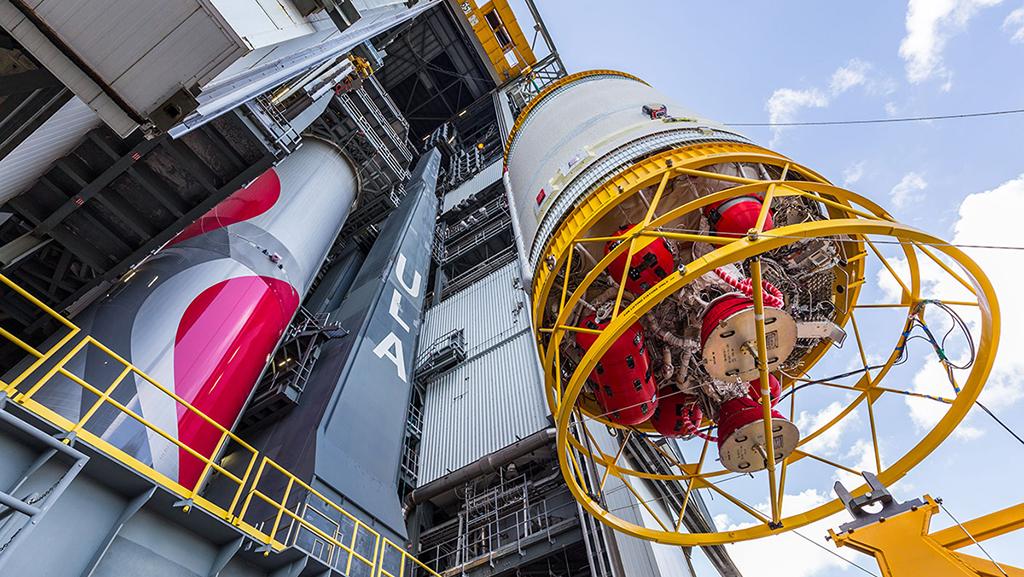
This Centaur V, pictured being hoisted atop the Vulcan Cert-1 booster in the Vertical Integration Facility at Cape Canaveral SFS Launch Complex-41 in February, previously assigned to fly the first Vulcan mission, known as Cert-1, will be retrofitted and reassigned.
After a decade of development, it is not the all-new, methane-fueled BE-4 main engine—manufactured by startup Blue Origin—that is delaying the debut flight of the United Launch Alliance Vulcan rocket. Instead, the postponement is due to an unexpected modification of the Centaur upper stage, a vehicle with more than 60 years of flight heritage.
The latest Centaur design, known as the Centaur V, is nearly twice the size of the current Centaur III that flies on United Launch Alliance (ULA) Atlas rockets. Designed for high-energy, long-duration missions, the Centaur V is a 40-ft.-long, 18-ft.-dia. vehicle built from stainless steel sheets thinner than a dime. The metal is welded to form a cylinder with domes at the top and bottom. The vehicle is propelled by liquid hydrogen and liquid oxygen.
- Delay bumps National Security Space Launch mission to second quarter of 2024
- U.S. Space Force is sticking with two-flight certification plan
ULA was about halfway through its 15th Centaur V structural test at NASA Marshall Space Flight Center on March 29 when a hydrogen leak developed from a crack near the vehicle’s forward dome. The leak continued for about 4.5 min., growing in size and gathering above the stage.
“It reached a flammable concentration, found an ignition source and caught fire because it’s in an enclosed space,” ULA CEO Tory Bruno told reporters on July 13. “It overpressured, and that damaged the test stand and also severely damaged the test article.”
It took a while to access the stand, as the Centaur V’s liquid-oxygen tank had been filled with 100,000 lb. of liquid nitrogen for the test that took several days to boil off. Then all the test equipment that had fallen on top of the damaged vehicle had to be removed—including a mass simulator, a mechanical loading structure and platforms.
ULA retrieved the remains of the damaged forward dome, which had caved in and been torn into fragments, to determine the cause of the leak—it turned out to have originated adjacent to a door at the top of the dome.
“The door is a very thick, stiff stainless-steel structure,” Bruno said. “Between that, the milled regions and the long-seam welds which radiate outward from the center to the outer periphery where it connects to the cylinder, we have a very complicated load- and stress-state.
“We discovered there was a stress-riser, or a load intensification, right at that spot,” Bruno said. “We would expect to have a certain load profile across that dome, but right in that narrow region the loads went way up because of this complicated geometry.
“The coarser analysis we did several years ago to determine the load design to design to did not catch that,” Bruno added. “And that particular phenomenon was not present on Centaur III because of its smaller scale and slightly different geometry.”
The unanticipated higher load was not the only problem. ULA had switched from a gas tungsten arc welding process for the seams on the Centaur III tanks to finer-detailed laser welding for the Centaur V. Those laser welds turned out to be less strong than samples, Bruno said.
“The higher loads and somewhat lower strength on the welds are what caused the crack to begin,” he added.
ULA had already decided to return to arc welding on the Centaur V’s 12-ft. seams because the precision of the positioning needed to set up the robotic laser welding technique was not saving production time as anticipated, Bruno said.
Fixing the Centaur V is relatively simple: ULA is making the top of the dome a little bit thicker. “The corrective action is a pretty low-tech thing,” Bruno said. “We will simply put in another layer of stainless steel . . . a ring doubler on top of the welds around that door and weld that on. Then add strips of stainless steel from there outboard down the dome about 2 ft. to cover that much of the weld. After that, the stresses are so low that you have no concerns.”
ULA began the work well before its accident investigation concluded, and it expects to have the first modified Centaur V ready for testing to support a Vulcan Centaur launch before year-end. ULA plans to use the flight article to complete structural testing, Bruno noted.
The mission, known as Cert-1, is the first of two required before ULA will be allowed to fly U.S. national security satellites on the new booster. Cert-1 will carry a commercial lunar lander for Astrobotic, two demonstration satellites for Amazon’s planned high-speed-internet Kuiper network and other secondary payloads. Cert-2, targeted for early 2024, would launch Sierra Space’s first Dream Chaser cargo ship to the International Space Station for NASA.
Meanwhile, ULA plans to use the Centaur assigned to the Cert-2 mission to complete certification testing.
The Centaur V earmarked for the first National Security Space Launch (NSSL) mission, which is expected to be Vulcan’s third flight—and the first to undergo the modification—will be used for Cert-1.
The upper stage previously planned for Cert-1 will be retrofitted and most likely flown on Vulcan’s third flight, the NSSL mission now targeted for the second quarter of 2024.




